Osprey AG system was introduced several years ago and they were adding it to many of their packs series. But there is an opposite trend now. So the question is why this is so?
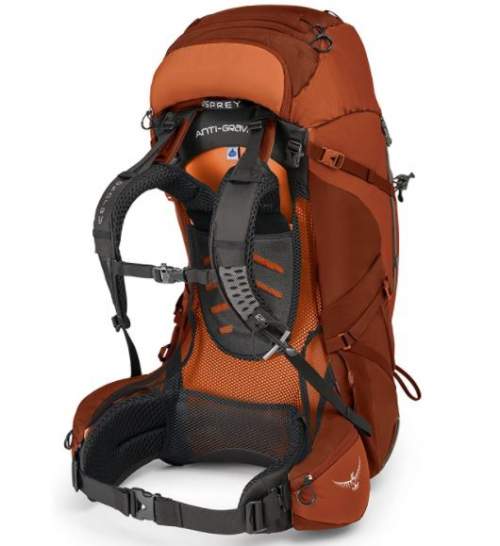
Those who follow the backpacks industry surely remember the time when Osprey announced its unique anti-gravity or AG design. It was totally revolutionary and unlike anything on the market those days, and this is still so. It looked so cool. I remember statements that with an Osprey AG pack you actually wear a pack and not carry it.
The idea behind this statement and behind the AG concept is that the weight is so perfectly distributed all over the body that you do not fee the weight. This is why the unique tensioned mesh system in Osprey AG packs is in contact with your body all over the back, the shoulders, and the hip belt.
Though in one of my previous texts I argued that there was nothing anti-gravity there. If you have the pack on your back, you have to carry its weight and you will feel it.
They had (and still have) this AG system in their smaller packs, and also in the largest packs that they have. You can see this Osprey Manta 28 AG as one example of the small packs. For such small packs, it works really great, you have great ventilation, the pack is separated from the body, and you almost ‘wear a pack’.
In the larger packs you can see it in Osprey Atmos 50 AG, in Osprey Ariel AG 65 pack for women, in Osprey Aura AG 65 and in many more. It is easy to get delighted when you see how it looks.
An important detail in some of the packs with this AG design is also the molding hip belt. This means that the foam in the belt molds by your body heat or in a specific oven, so that it adjusts perfectly to the body shape. They used it also in some packs that are not AG-type, and you can see it in this great Osprey Xena 70 pack for women. But it appears they are abandoning this design too, at least it is absent in their latest Aether & Arial Plus packs series.
But some time ago they launched their new Osprey Manta & Mira series without the AG design. This was quite a surprise because I was expecting they would abandon this system in their larger packs designed for heavy loads. Namely, Manta and Mira are small packs for day tours mainly.
However, as you can read in my separate text, for the season 2021 they have launched new versions of their famous Aether and Ariel packs that are now under the name Aether Plus and Ariel Plus. They even go to the volume of 100 liters with the largest of the packs with the word Plus in the name. In fact, I have no idea what this word Plus stands for. My guess is that these packs are just additions to the usual two smaller sizes of the Aether & Ariel series that have also appeared these days.
So for such large packs, switching back to the classic design is more understandable to me. It looks like rediscovering hot water.
♦ They write about “a significant upgrade” in the custom fit. But I mentioned molding hip belt, so I would say there can be no more perfect fit than this.
♦ Note also that this is not only about the packs from the Plus series (whatever this means). As mentioned, they also have an ‘ordinary’ Aether parallel to the Plus, see them both in the picture that shows the new Osprey Aether 55 and Osprey Aether Plus 60, the latter looks much bulkier:
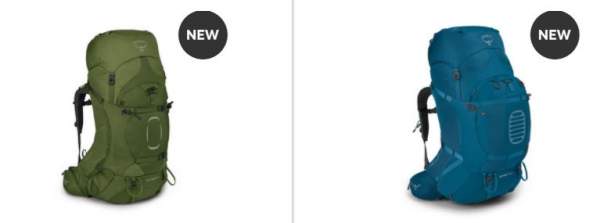
♦ The same is with the Ariel series for women, the picture below shows the Osprey Ariel Plus 70 (left) and Osprey Ariel 55 (right), none of them has AG features:
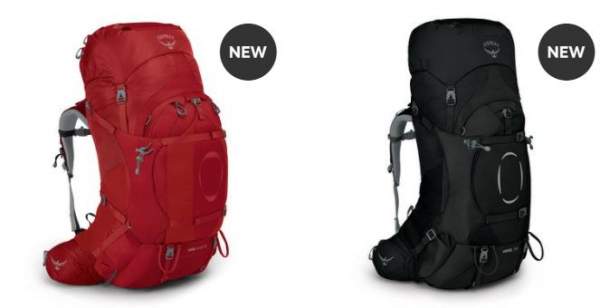
♦ However, they keep the AG packs as well, and they are available on the market. So this is quite a mess.
But if you are curious to see how the new system looks, see the picture below that shows the new hip belt and the massive lumbar padding, this is Osprey Ariel Plus 70 pack for women:

Here you have their new design that they call the Custom Fit-on-the-Fly Hipbelt with hip fins that attach by Velcro tabs, so you can move them backward and forward and also change their angle a bit.
Practically the same is in the non-Plus version, the picture below shows the new Osprey Aether 55 which is non-AG as well. Here too you have the Custom Fit-on-the-Fly hipbelt, and Custom Fit-on-the-Fly shoulder strap and adjustable torso length:
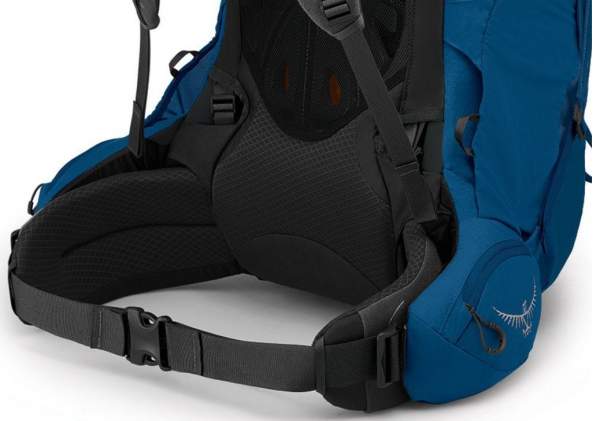
Now, if you are not really familiar with the previous AG design, see how great it looks:
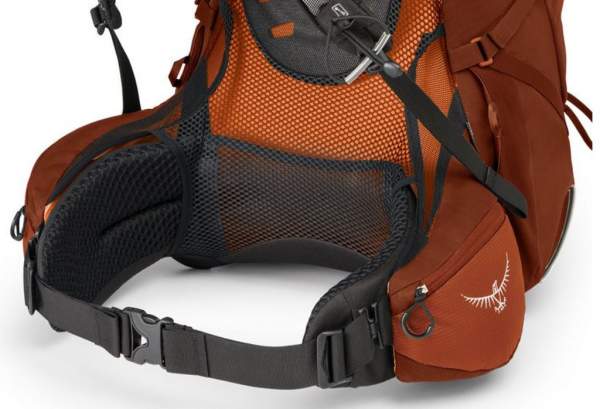
The big difference is in the lumbar area where you have just a mesh. This is fine for small packs like what I have in my Osprey Stratos 24 daypack that is described as “AG-inspired”, but for packs for heavy loads having a massive lumbar padding may be essential.
Instead of summary
A few years ago it looked as if Osprey would be introducing its AG design in more and more of its packs. But now we see that they are turning back to the basic designs with massive hip belt padding. Instead of the AG design, you can see a tensioned trampoline style back panel, they have introduced it in several series like Rook and Renn packs and Stratos and Sirrus.
But let’s get back to this new series. There are several new features in the new Aether and Ariel packs, but the hip belt design looks like a step back to their original design that was used before the AG design. It looks a bit similar to what you have in their Aether & Ariel Pro series.
I am a bit surprised that they did not introduce this new design to their Atmos and Aura AG series. This is because Aether and Ariel AG already had a perfect hip belt padding (but perhaps not equally perfect lumbar design for heavy loads), while Atmos & Aura AG do not have much padding on the hip belt. See below how their hip belt looks:
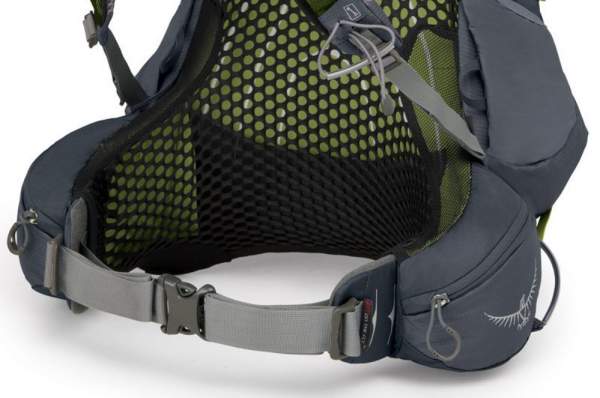
I wonder if they are going to change this too. In any case, all these packs are available at Osprey’s site so please follow the link to see more. Read also my detailed text about the new non-AG Osprey Aether 55 pack for men and also in the text about Osprey Ariel 55 pack for women.
What do you think about all this? It will be great to hear your thoughts, there is a comment box below. Thank you for reading and have a nice day.
John says
I was told they stopped them on the smaller packs at least because of the squeaking that so many were having problems with. I have that problem intermittently on both my Manta 28 and 34, although not frequently enough to stop me from using the packs.
Jovo says
Thank you John. I have seen a number of people complaining about squeaking. I wonder if this is the only reason. Interesting that you mentioned it was intermittent. Perhaps Osprey has some idea why it would appear sometimes and not always. Pitty in any case, the packs with that suspension look really great.
Eric says
I’ve read numerous articles that the AG system is great for smaller loads but when you put on a bigger pack it tends to bounce around a lot.
Jovo says
Hi Eric, this is most likely so, but they are removing it also from their small packs.
Daniel Bardsley says
This is a very interesting article. It is surprising that Osprey is ending the AG system for the Aether, as the Aether AG seems to get excellent reviews from users. I used to own an Atmos AG and found the back system to be extremely comfortable and breathable, much more so than on any other pack I have tried (I sold the pack, though, because I found the hipbelt uncomfortable). Perhaps Osprey reverted to a close-contact back system for the Aether because this set up is good for extremely heavy loads, although the company already has the Xenith model for the heaviest loads.
Jovo says
Hi Daniel, what you are saying could be an explanation for larger packs, but there is the same trend with small packs, this is not easy to understand. Thank you for commenting.
Maxim says
Jovo, I read your reviews with great pleasure! Thank you for your work!
Jovo says
Many thanks Maxim, I appreciate this.
Maxim says
Perhaps the grid is a more expensive and time-consuming solution with less strength.
Today, there is a lot of competition in the backpack market, so the Ospreys are moving towards reliability, not beauty.
Maxim says
or a reduction in the cost of production of the product, but not a reduction in the price )))
marketers – what else can I say..
Jovo says
Actually trampoline style tensioned mesh is appearing more and more, you have it in Osprey and Gregory, earlier this was Deuter only. But Deuter has always used a massive hip belt and lumbar padding, they know this is essential.
Maxim says
Jovo hi!
My opinion, I’m talking about large backpacks, the new design is more reliable and practical than the mesh.
I have a Gregory Baltoro 85 (previous model) and their back and belt are made in a similar way, very convenient, after 15 kilometers with a backpack of 25 kilograms I do not get tired and my back does not hurt. it was checked more than once on a long road.
For backpacks up to 40 liters, I would prefer a grid as this is a more ventilated back, and things in such a backpack are taken a little.
Jovo says
Mani thanks Maxim, I think I can agree with you in all these aspects. Packs with heavy loads require good contact with the body, so lumbar padding plays a big role; the mesh used in the AG was not the best option in their large AG packs. But what surprises me is the fact that they are abandoning this AG design even in small packs.